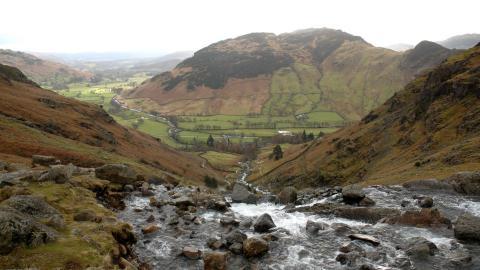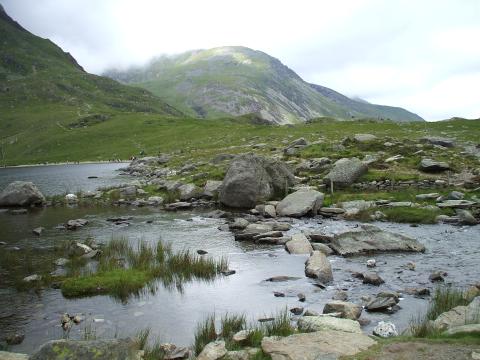- Prevalence and distribution of animal and plant species in streams and ponds.
- Ecological condition of streams and ponds, assessed for the first time based on the diversity, abundance and composition of the flora and fauna*
- Physical condition of streams and their riparian corridors (ie. the land adjacent to watercourses).
- Estimates of the number of ponds.
- Links between the characteristics of catchments and the ecological status of streams within rural landscapes*
*key areas that need to be addressed as part of our drive to implement the EU Water Framework Directive
We have collected data on 455 streams & watercourses across GB
Streams

Squares that were studied during the 2000 Survey were re-surveyed in 2007 – with particular focus on sites that have a continuous time series since 1990.
Fieldwork in each square has involved:
- Sampling the stream macroinvertebrate community (eg. insects, crustaceans, molluscs and worms), using the River Invertebrate Prediction and Classification System (RIVPACS) method.
- Recording associated RIVPACS information*
- Recording the hydromorphological status of the site, using the 2003 River Habitat Survey method.
- Surveying the aquatic plant community, using the Mean Trophic Rank (MTR) method.
- Taking an indicative sample of water chemistry - analysed for pH, conductivity, alkalinity, Soluble Reactive Phosphorous (SRP) and Total Oxidised Nitrogen (TON).
*includes stream width and depth; velocity and discharge; substrate composition; altitude; distance from source; slope.
Ponds

The 2007 Survey assessed the biological condition of one pond in every square where they were found (259 in total). The study involved a new approach to biological surveying, which allows accurate assessment of change in the status of lowland ponds since 1996 – and for the first time, a UK and country-level assessment of the condition of the national pond stock.
Fieldwork at each pond has involved:
- Surveying the aquatic plant community, using the National Pond Monitoring Network (NPMN) method
- Recording associated NPMN information*
- Taking an indicative sample of water chemistry - analysed for pH, conductivity, alkalinity, Soluble Reactive Phosphorous (SRP) and Total Oxidised Nitrogen (TON).
*includes pond area; wetted area; depth; substrate composition; number of inflows/outflows; evidence of management, impacts of livestock; fish; water birds; surrounding land-use; amenity value.
Management of the pond biological survey was undertaken by Pond Conservation - the national experts on research, policy-advice and fieldwork on ponds. For more information visit the Freshwater Habitats Trust website.
Survey Outputs
Data collected from the 2007 Survey have been used to report on:
- Change in prevalence of stream macroinvertebrate and aquatic plant taxa. This will include listing those taxa that show significant changes and highlighting occurrencies of rare or threatened species.
- Change in stream macroinvertebrate and aquatic plant taxon richness.
- RIVPACS bioassessment of surveyed streams. This will include determining the likelihood that there has been a real change in quality at each site between 1998 and 2007. It will also involve reporting on the percentages of sites in each country (and Environmental Zone) that have “more likely than not” or “almost certainly” changed in quality.
- Mean Trophic Rank (MTR) bioassessment, using aquatic plant data from Countryside Survey 2000 and 2007 (an index value based on the presence and cover of certain plant species indicative of different levels of nutrient enrichment).
- Change in the hydromorphological condition of streams.
- The hydrochemical nature of the water at each site.
- Relationships between land use, spatial scale and stream biological and physical integrity.
- Changes in pond stock between 2000 and 2007.
- Prevalence of aquatic plant species across ponds (wet and dry). This will include highlighting occurrences of rare, notable or invasive species.
- Change in prevalence of individual aquatic plant species in ponds between 1996 and 2007.
- Change in aquatic plant taxon richness between 1996 and 2007.
- Bioassessment of pond condition.
- The hydrochemical nature of the water in each sampled pond.

